Last Updated on 7 May 2024 by Cycloscope
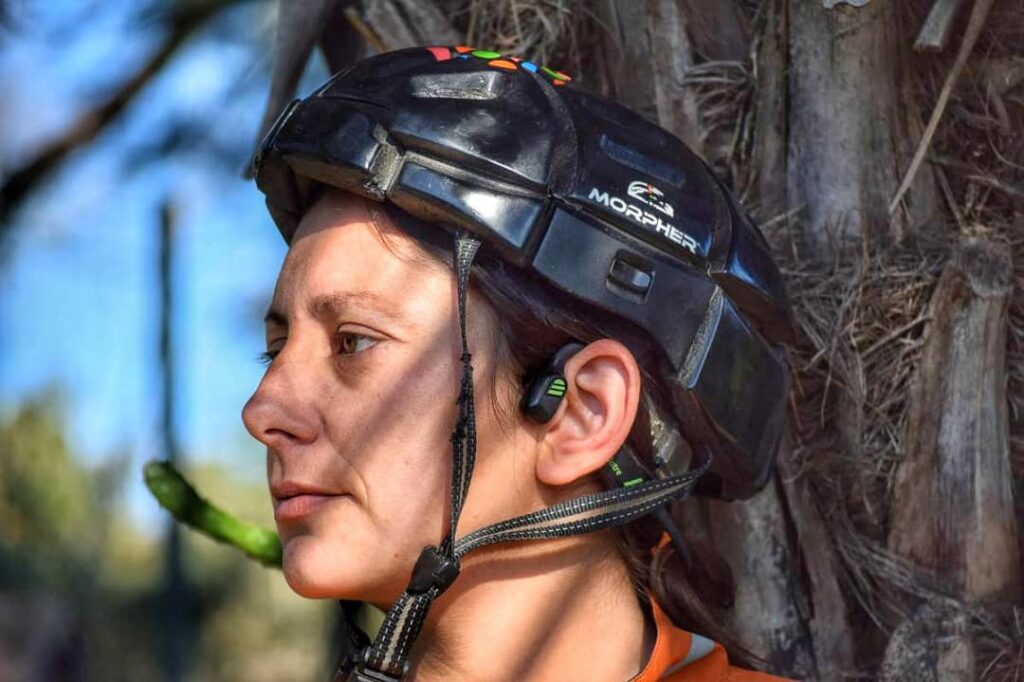
What are the best headphones for cycling in 2024? Should you cycle with earphones or earbuds?
Bluetooth, Wireless? Bone Conduction? Wearable Speakers?
How to stay safe when cycling with a headset on
What are the best headphones for cycling? Should you cycle with headphones or earbuds? What characteristics should you be the most aware of when choosing earphones or earbuds for biking?
Disclosure: Some of our articles contain affiliate links. This comes at no additional cost for you and helps us keep this website up and running. (as Amazon Associates we earn commission from qualifying purchases)
How we compile our gear guides: during the almost 10 years of cycloscope.net our team personally tested dozens of similar pieces of gear. For what we can't test personally, we involve other people in the cycling community to give their feedback and opinion about gear they have used. Our decade-long experience in bicycle touring enables us to find the key cons and pros of every product we mention.

Bluetooth? Wireless? Bone Conduction? Will these be comfortable under my bike helmet?
We’ll try to answer these questions in this blog article, where we’ll dig deep into our findings to give you all the instruments to choose which headphones or earbuds are the best for your biking needs.
Even though most of the time we want to be aware of our surroundings, during our 6-year (so far) bike trip around the world, we often found ourselves on long, boring, but quiet sections where we really wished we could listen to some music or podcasts while cycling.
So we decided to explore what the market has to offer when it comes to cycling headphones, earphones, and wireless Bluetooth earbuds.
We have to be clear about the fact that none of these headphones are specifically meant for biking, what we list here are the best sports headphones that, in our opinion, will work well for cycling, which means with a helmet on and constant wind noise.
The Best Biking Headphones In-A-Nutshell
| Model | Type | Price | Link |
|---|---|---|---|
| Shokz OpenRun | Bone Conduction | 160$ | Buy on Amazon |
| Vidonn F1 Titanium | Bone Conduction | 60$ | Buy on Amazon |
| Klatre LS1 | Bone Conduction | 100$ | Buy on Amazon |
| Shokz OpenMove | Bone Conduction | 80$ | Buy on Amazon |
| PURERINA Bone-Conduction | Bone Conduction | 60$ | Buy on Amazon |
| Powerbeats Pro | Earbuds | 200$ | Buy on Amazon |
| Jaybird Vista | Earbuds | 160$ | Buy on Amazon |
| Apple AirPods Pro | Earbuds | 250$ | Buy on Amazon |
| Sony WF-SP700N/L | Earbuds | 50$ | Buy on Amazon |
| Bose SportSound | Wireless Earphones | 130$ | Buy on Amazon |
| Boltune True Wireless | Earbuds | 40$ | Buy on Amazon |
| Anker Soundcore Spirit | Wireless Earphones | 35$ | Buy on Amazon |
| TREBLAB XR500 | Wireless Earphones | 30$ | Buy on Amazon |
| JBL Endurance Run | Wired Earphones | 20$ | Buy on Amazon |
| Zulu Audio | Wearable Speakers | 32$ | Buy on Amazon |
15 Best Headphones for Cycling Compared
We’ll divide this cycling headphones buying guide into four sections, the first is dedicated to bone-conduction cycling headphones (the safest option), the second to earbuds suited for cycling, and the third to cheap but quality headphones for those on a budget.
We have updated the list with some new products for 2024!
In the final part, we’ll explain the most important aspects to consider when buying the best cycling headphones for your needs.
5 Best Bone Conduction Headphones for Cycling
Unlike traditional headphones, which send sound through the ear canals, bone conduction technology delivers audio through the cheekbones.
With nothing inside or over your ears, you can enjoy total awareness of your surroundings while you listen to your podcasts or audiobooks. Don’t expect the same experience as traditional earphones though.
> Best Bone Conduction Headphones for Cycling – Open Ear Design for Biking Awareness
1. Shokz OpenRun Bone Conduction Headphones

Best Bone Conduction Headphones for Cycling
Under 200$ [Check The Latest Price]
Shokz (formerly Aftershokz) is the leading manufacturer of bone conduction headphones, with a technology one step ahead of the competitors. The OpenRun (formerly Aeropex), like the other wireless Shokz models, are the closest items on the market to what could be considered the best headphones for cycling.
The level of awareness is total, although of course, you’ll have to compromise on sound quality, like with all bone-conduction headphones. The Aeropex is the top model in the Aftershokz gamma, and the price reflects that – but they are definitely the best bone conduction headphones up to date.
Completely sweat and waterproof, the AfterShotz Aeropex cycling headphones are designed for tough workouts and adventures in the most extreme weather conditions.
Although they are not suitable for swimming, some people still use them for that and never have problems, for sure they’ll withstand a shower. A moisture detection sensor alerts you if the charging port gets too wet to be safe when charging.
Weighing less than 1 ounce (26g), they feature dynamic bass, higher volume, and less vibration (a slight tickle common to bone conduction) compared to other bone conduction models.
They can connect with two devices at the same time, which might not be important for cycling but makes them versatile for work.
As we already said, bone-conduction headphones can’t replicate the amazing bass of an expensive pair of earbuds or headphones. That said, when wearing earplugs these things easily sound at least as good as a “decent” pair of headphones (like $20-40 range, more than adequate unless you are an audiophile). They are still the best-sounding bone-conduction cycling headphones up to date (2021).
Without the earplugs in, with open ears alert to your surroundings, the Shokz OpenRun sounds similar to stock Apple iPhone earbuds, maybe with a bit less bass.
The purchase includes two magnetic charging cables (very solid) a handy sports belt and 2 years warranty.
Specifications
- Listening Time: 8h (10 days of standby time)
- Charging Time: Full Charge – 120 min
- Controls: Voice control plus 1-button
- Wireless Range: 40 feet (12 m)
- IPX Rating: IPX67
Pros:
- Great for awareness
- High waterproofness
- Longest battery life among bone-conduction sport headphones
- Best sound quality among bone conduction
- Stays firmly in place
Cons:
- Pricey
- Loud beep sounds are not adjustable
What’s in the box: AfterShotz Aeropex sport headphones – 2 x Magnetic charging cables – User manual – Earplugs – Rubber case – Sports belt.
2. Vidonn F1 Titanium
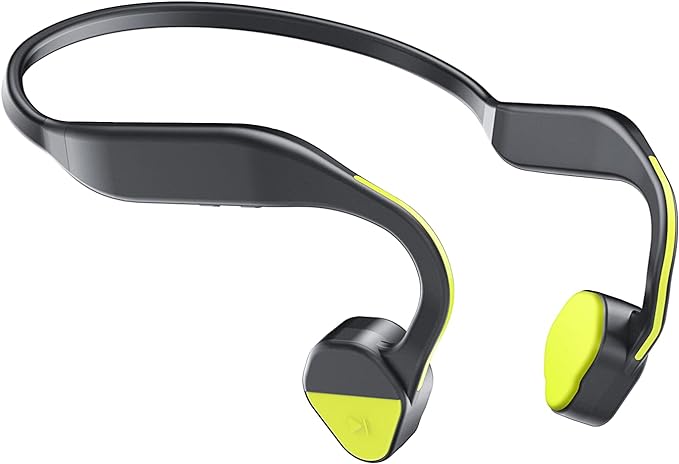
Under 50$ [Check The Latest Price]
A bit cheaper than the AfterShotz Aeropex (available on Amazon for 60/120$, keep an eye on special offers), made in titanium, alloy, and TPU, the Vidonn F1 is another interesting option when it comes to choosing the best biking headphones for your needs.
They are a bit heavier than the Aeropex (38g) but very comfortable to wear, if they feel tight, you can move the backbone upward, adjusting to the proper position also improves the sound experience.
Like with the Aftershotz, you can use the included earplugs to close your ears and feel the pure bone conduction tone quality.
Their biggest downside used to be poor connectivity but the Bluetooth has been recently upgraded from v4.1 to 5.0, so it should be more stable.
Specifications
- Listening Time: 5h (7 days of standby time)
- Charging Time: Full Charge – 120 min
- Controls: Voice control plus 1-button
- Wireless Range: 33 feet (10 m)
- IPX Rating: IPX55
Pros:
- Great for awareness
- Ultralight
- Comfortable (the band in the back is not really intrusive)
Cons:
- Poor battery life
- Unreliable connectivity
- Prone to interference
What’s in the box: Vidonn F1 headphones – USB charging cable – User manual – Noise-proof earplugs.
Durability: 7 | Sound Quality: 8 | Battery Life: 7.5
3. Klatre LS1 – New Entry 2024!
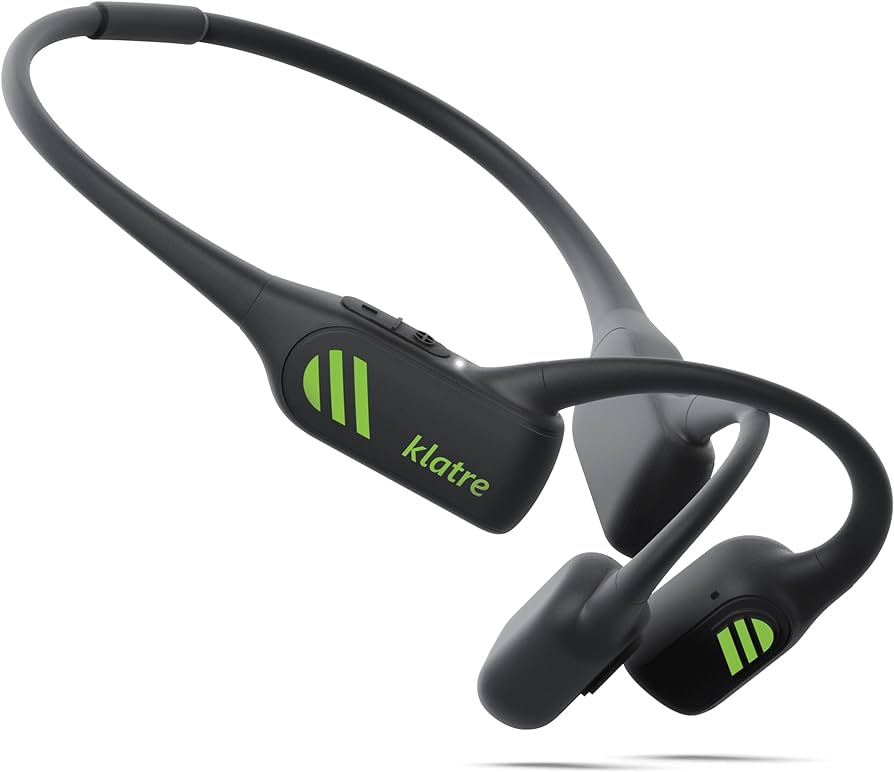
Under 100$ [Check The Latest Price]
Klatre is the new player in the bone conduction game. With their LS1 they enter the market with a great value-for-money product.
Ultralightweight at less than 31g, and with a slick design, they are basically unnoticeable when you have them on – while staying firmly in their place.
Their strongest points? An 8-hour battery life, is fully charged in about 1 hour, and has a surprisingly long wireless range.
About the latter, they claim only 10 meters (33 ft) on their booklets, but I’ve personally experienced perfect signal even beyond 20 meters and with a wall in-between!
Sound quality is comparable to other bone-conduction headphones, if you’re an audiophile and want to listen to all the details and dynamics of music these won’t be your go-to headphones at home.
They are great headphones for cycling, running, and other outdoor activities that require awareness of your surroundings – outside noise comes in clear even when at maximum volume.
If you’re a podcast addict, these headphones will really be a great buy and you’re likely to use them also at home. You can also use voice control by pressing and holding the large multifunction button to activate the voice assistant, quick and handy.
On the downside, music with strong basses can cause an annoying vibration at the temple – a problem shared by all bone-conduction headphones. To solve this, just use an EQ (equalizer) to reduce the loudness of the bass frequencies.
Read our full review of the Klatre LS1 bone conduction headphones
Specifications
- Listening Time: 8-Hours
- Charging Time: Full Charge – 60 min
- Controls: Voice control plus 1-button
- Wireless Range: 66 feet (20 m)
- IPX Rating: IPX55
Pros:
- Great battery life
- Lightweight and almost unnoticeable
- Pouch included
- Quick charging time
Cons:
- Bass vibration can be annoying at loud volumes
What’s in the box: Klatre LS1 headphones – 2x USB to Pogo Pin charging cables – Noise-proof earplugs – Headphones pouch – User manual.
Durability: 7 | Sound Quality: 8 | Battery Life: 7.5
4. Shokz OpenMove
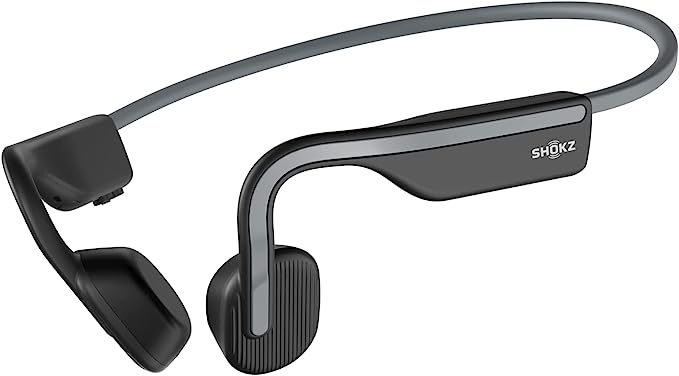
Under 90$ [Check The Latest Price]
The Shokz OpenMove is the little brother (or sister) of the OpenRun, they cost less and are small and comfortable but lack the outstanding performances of their sibling.
The Wireless Bluetooth connection is a bit faulty, IPX waterproof rating is just an IPX55, perfect for sweat and rain but forget about taking a shower with these on.
Sound performance is still great for bone conduction headphones but it doesn’t match the OpenRun, although the app EQ preset can help with that.
The titanium band offers durability and flexibility, while the LeakSlayer™ technology minimizes sound leakage. The dual noise-canceling microphones reduce external noise, making the call quality more than acceptable.
They fit only smaller head sizes. For larger heads, check the AfterShokz Trek Titanium, same specs but a larger headband.
Specifications
- Listening Time: 6h (10 days of standby time)
- Charging Time: Full Charge – 90 min / 15-minute charge gives 1 hour of playback
- Controls: Volume & track controls on each earbud, voice capability, auto Play/pause
- Wireless Range: 33 feet (10 m)
- IPX Rating: IPX55
Pros:
- Great for awareness
- Ultralight
- Very small and comfortable
Cons:
- Only fits small heads
- Connectivity issues (Bluetooth v4.1)
- Poorer sound compared to the Aeropex
What’s in the box: AfterShokz Trekz Titanium Mini headphones – USB charging cable – Earplugs (for blocking ambient noise) – Soft carrying bag.
Durability 9 | Battery life 8.5 | Sound quality 7 | Comfort 7.5 | Value for money 7.5
5. PURERINA Bone Conduction
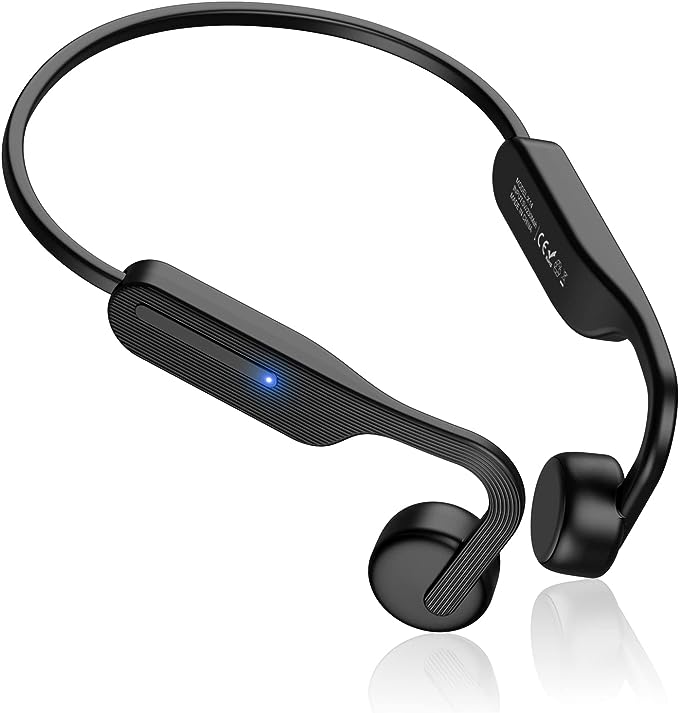
Under 30$ [Check The Latest Price]
Best cheap bone conduction headphones for cycling
These budget bone conduction headphones by Purerina are great for those cyclists who just want to listen to some podcast or audiobook while riding. The built-in 230mAh lithium battery supports a standby time of up to 10 days, phone calls for up to 8 hours, and music plays for up to 6 hours.
The waterproof rate is IP55, with no need to worry about sweat or downpours, while connectivity via advanced Bluetooth 5.0 is faster and more stable than the Bluetooth 4.2 used by some competitors, up to 10 meters from the device and up to two devices at the time.
A downside is the low playback volume, which can result in inaudible sound in noisy environments and a somehow short lifespan, typical of this cheap range of products where quality control is sacrificed to keep the price as low as possible.
30-day free replacement and 12 months of warranty service have your back covered in case you don’t like them, they really are a bang for the price.
Specs:
- Listening Time: 6h
- Charging Time: Full Charge – 2h / 5-minute charge gives 1. 5 hours of playback
- Controls: Volume & track controls on each earbud, voice capability, auto Play/pause
- Wireless Range: 33 feet (10 m)
- IPX Rating: IPX54
Pros:
- Great for awareness
- Good quality cheap bone conduction headphone
Cons:
- Not really adjustable, might not fit your head
- Muffled sound
What’s in the box: EKEN Bone Conduction Headphones – USB charging cable – Case
5 Best Wireless Headphones-Earbuds for Cycling
Earbuds eliminate any kind of cable, those with transparency mode make you able to listen to your surroundings, and some have great battery lives. On the downside, they can fall off and are easy to lose.
> Best Earbuds For Cycling: Bluetooth/Wireless Biking Earbuds
1. Powerbeats Pro – Totally Wireless Earphones
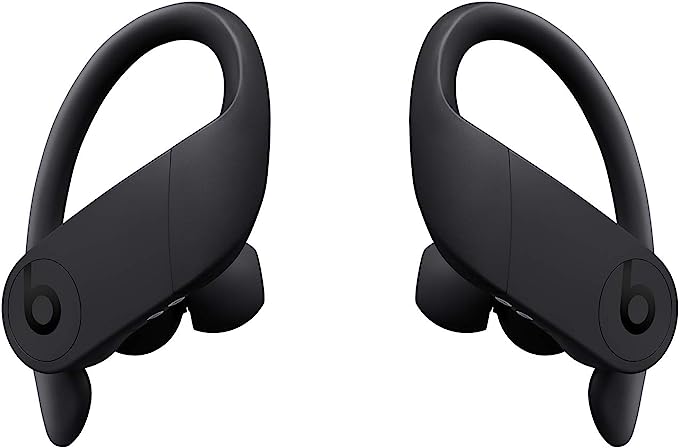
Battery life 9.5 | Sound quality 8 | Sweat Resistance 8 | Comfort 8
Under 250$ [Check The Latest Price]
Let’s approach the world of sports earbuds, how good are they for cycling? The Powerbeats Pro has a few strong points that make them interesting for bikers.
The adjustable, secure-fit ear hooks make sure they stay in place and not fall on the ground. They come with 4- sizes of interchangeable ear-tips, easy to find a perfect fit, and you can play around with them to match your desired grade of noise-insulation. One of those ear-tips is cone-shaped, meant to let more ambient noise in, you might want to use that when cycling on unprotected roads.
The sound is powerful, and balanced, with a high dynamic range but lacks somehow in the midrange. Call quality is also very good. The Powerbeats Pro isn’t completely noise-canceling (don’t block out ambient noise), which is better for cycling. In case you still don’t feel safe, you can wear only one, as those cycling earbuds are completely independent of each other.
The downside is mainly their size, a bit too big and heavy might cause annoyance when worn with a helmet and sunglasses.
Specifications:
- Listening Time: 9h (24h with charging case)
- Charging Time: Full Charge – 90 min / 5-minute charge gives 1. 5 hours of playback
- Controls: Volume & track controls on each earbud, voice capability, auto Play/Pause
- IPX Rating: IPX4
Pros:
- Great Battery Life
Cons:
- Big and Uncomfortable
- Not totally waterproof
- lacks midrange
What’s in the box: Power Beats Pro totally wireless earphones, charging case, ear tips with four size options, Lightning to USB-A charging cable, quick start guide, and warranty card.
2. Jaybird Vista – True Wireless Bluetooth Sport Waterproof Earbuds
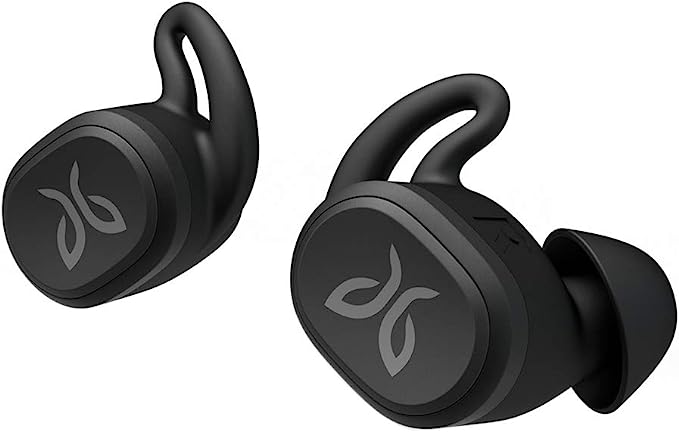
Sound: 8.5 |Fit & Comfort: 8 |Connectivity: 10 | Weight: 10 | Durability: 9
Best Headphones for MTB
Under 200$ [Check The Latest Price]
Second pair of cycling earbuds in this review, how do they compare? Well, those are very small much lighter, and more comfortable compared to the Powerbeats Pro. They are also IPX7-rated, which means fully waterproof, you can shower with them and even swim (although swimming is not recommended).
They come with three sizes of interchangeable ear gels to ensure a secure fit, they stay in place, and you’re able to take off a t-shirt without the earbuds flying out.
What might be a concern for the cyclist is that those are in-ear-canal phones with great passive noise canceling and do not have passthrough ability (transparency mode), so it can be rather hard to hear the outside world, especially if the music is loud.
The Jaybird Vista’s sound quality is great with options to customize with the equalizer. They feature a decent microphone for calls in a reasonable outdoor environment. The person on the other side can easily tell that you’re using a headset of some sort, but that happens with all earbuds.
They have no Master/ Slave design, both earbuds can connect to the device independently, which allows for a consistent audio connection, although interference is experienced when there are many wireless devices around). Unfortunately, they allow only one function with a single button. No options for the previous track.
Another interesting feature is the “Find My Buds” function, which keeps track of your earbuds through the Jaybird app. The case is compact and lightweight.
Specs:
- Listening Time: 6 h (16 hours with case)
- Charging Time: Full in 2h / 5-minute charge gives 1 hour of playback
- Controls: Limited to single function button on each earbud
- IPX Rating: IPX7
Pros:
- Ultralight
- Cheaper than most direct competitors
Cons:
- Prone to interference
What’s in the box: Vista Wireless Sport Headphones – Secure – Fit Eargels(3 sizes) – 1/2/3 – Charge Case – USB C Charging Cable.
3. Apple AirPods Pro
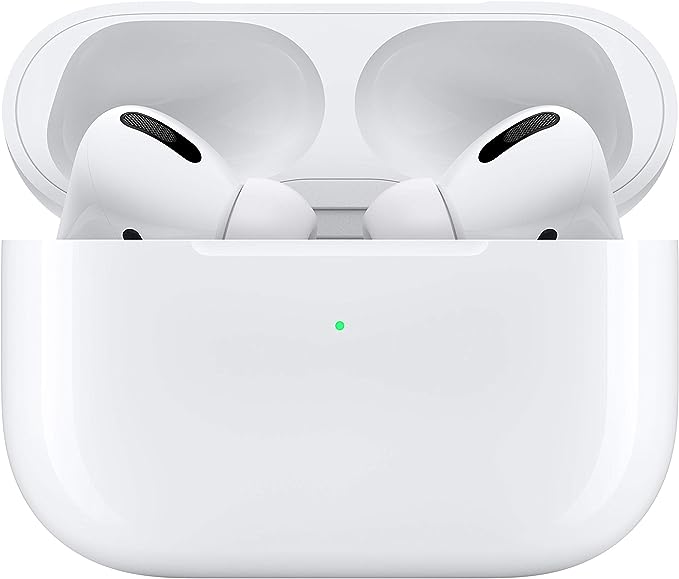
Under 250$ [Check The Latest Price]
Of course, Apple has its own model of sports earbuds, they have a lot of cool functionalities but hey… it’s Apple, so expect a crazy price tag and some compatibility issues.
Among the features that make them among the best earbuds for cycling, there’s certainly the transparency mode, the Apple AirPods Pro have active noise cancellation for immersive sound but with the transparency mode, you can let in as much ambient sound as you desire, for hearing and connecting with the world around you.
The sound is good but not the best, an adaptive EQ automatically tunes the music to the shape of your ear, at least allegedly. Call and mic quality is the best available.
Three sizes of soft, tapered silicone tips allow for a customizable fit, although the Apple Airpods Pro has the ugly vice of falling off sweaty ears, and you don’t want to lose a pair of 250 bucks earbuds.
Sweat/water-resistant grades are only IPX4, which means they are not totally waterproof. The battery life is average but the case holds a lot of charges and they get juiced up very quickly.
They are easy to set up for all your Apple devices and can access Siri quickly by saying “Hey Siri”. They can be paired with Android although not as easily as with iOS. The charging cable uses the stupid and overpriced Apple proprietary connector.
Specs:
- Listening Time: 4.5h (24h with charging case)
- Charging Time: Full Charge – 40 min / 5-minute charge gives 1 hour of playback
- Controls: Custom force sensors in each stem
- IPX Rating: IPX4
Pros:
- Transparency mode
- Easy to connect
- Easy to switch devices
- They stay in your ear really good as long as you’re not sweaty or greasy
- Can use Siri
- Can be used as a hearing aid
Cons:
- Not totally waterproof
- They can fall out of your ear if sweaty
- Noise cancellation is minimal
- Apple proprietary cable only
What’s in the box: AirPods Pro – Wireless Charging Case – Silicone ear tips (three sizes) – Lightning to USB-C Cable – Documentation.
4. Sony WF-SP700N/L
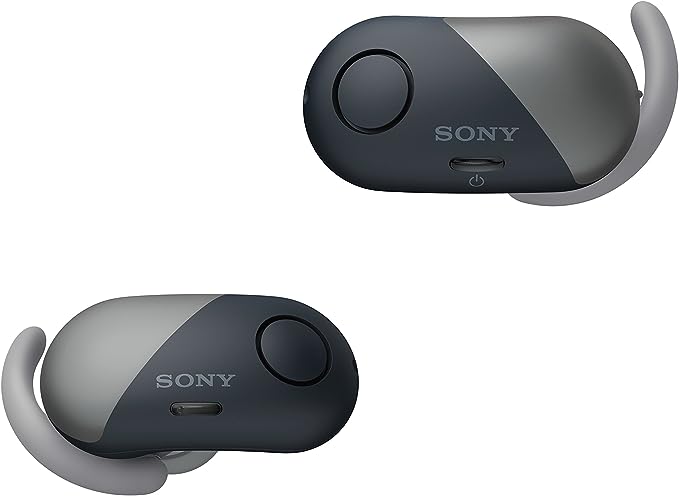
Best Quality Earbuds for Bike Commuting
Under 50$ [Check The Latest Price]
Here’s another big player whose sports earbuds can’t be omitted from this buying guide/review. Now that their price has been slashed by about 75%, the Sony WF-SP700N could easily be the best cycling headphones for city commuting.
Their ambient sound mode blends music and environmental sounds, making it safe to wear them while cycling in the city, while the active noise cancellation blocks everything if you wish to be completely immersed in your music (better than Airpods and Powerbeats).
Both settings work pretty well. You’re able to hear traffic noise with that option selected and can hear voices but not much else on the other.
What makes them best for commuting but not for long rides is the crappy battery life, only 3h on one charge and just 9 hours with the case, definitely a bummer.
The wind noise can get really loud when there are strong winds, but under normal wind conditions, the annoyance is negligible.
The sound stage is also pretty good. you can feel the music around you, not just inside your head. They are IPX4 rated to handle sweat or rain splashes but can’t withstand a shower.
Phone calls are not great, only come out in mono from the left earbud, and the mic picks up too much background noise.
The left earbud is master so they can’t be used independently (well, the left one can, but not the right). You’re able to use Siri and similar with the Sony WF-SP700N sports earbuds.
The earbud pad options really are great, they stay in place much better than the Apple AirPods. Bluetooth connection is stable up to 10 m (30 feet) away from the device.
Specifications:
- Listening Time: 3h (9h w. case).
- Charging Time: Full Charge – 2.5h / 15-minute charge gives 1 hour of playback.
- Controls: Single customizable button + App.
- IPX Rating: IPX4.
Pros:
- Good noise cancellation/ambient mode options.
- Sound great. Nice clear highs, good powerful bass.
- Low-profile design/Stays put in the ear.
- The Bluetooth connection seems pretty stable.
- 10m (30 feet) Bluetooth range.
Cons:
- Wind noise.
- Equalizer options can’t be manually tweaked.
- The Mic picks up a lot of background noise.
- Phone calls are mono only.
- Sucky battery life.
What’s in the box: Charging case – 2 x Arc Supporter (M/L) – 4 x Hybrid Earbuds Long (SS/S/M/L) – Micro USB cable.
5. Bose SportSound Wireless Cycling Headphones

Under 150$ [Check The Latest Price]
Switching from earbuds to wireless earphones. From audio-giant Bose here’s probably the best earphones for cycling and sports in general, at least when it comes to price/quality ratio.
The sound quality on these blows the beats out of the water, far better than all headsets mentioned so far.
This time, Bose did tweak the volume EQ a lot. You can hear tracks from various genres and the earphones will adapt to each song. No need to set your own eq or raise the volume to listen to your piano track.
You can hear ambient noise, they are not noise-canceling earphones, although for maximum awareness you might want to wear only one.
Battery life is great, 8 hours of continuous playback, and a 10-minute quick charge refills almost two hours of playback.
The Bose SportSounds stay comfortably in place during any kind of ride, and while the cord might be a bit annoying, it ensures that you won’t lose them. Sweat and weather resistance rated at IPX4 (splashproof).
The inline mic and remote to control volume, can skip tracks, take calls, adjust volume, and activate Siri (or similar). The buttons though are covered by a rubber membrane that sometimes makes them hard to press.
They are charged via a standard micro USB into the right ear-pod, which is covered by a flap of rubberized plastic which looks a bit weak.
The app is pretty bare-bones, with no EQ options allows you to stream the same audio to two pairs of Bose headphones.
Specifications:
- Listening Time: 6h (9h w. case).
- Charging Time: Full Charge – 2h / 5-minute charge gives 1 hour of playback.
- Controls: Inline-volume/Play/Pause.
- IPX Rating: IPX4.
Pros:
- Gorgeous Sound.
- Great volume and clarity.
- Connectivity is reliable and fast.
Cons:
- Weight is a bit on the heavier side.
- Very basic App.
What’s in the box: SoundSport wireless headphones – 3 sizes StayHear+ Sport tips – USB charging cable – Carrying case – Quick setup guide – Warranty card.
4 Best Budget Cheap Headphones for Cycling
1. Boltune True Wireless Waterproof Earbuds

Best Budget Earbuds for Cycling Long Rides
Under 40$ [Check The Latest Price]
All right, wait for a second, great sound, impressive playtime, totally waterproof… for less than 40 bucks? This sounds too good to be true, but it is! The Boltune is probably the best cheap wireless earbuds for cycling and all sports in general.
They feature Bluetooth V5.0 which ensures fast pairing and transmission speed, stable connectivity with no signal loss or music dropouts, and a range of up to 50ft away, even with walls in-between.
The music quality is breathtaking for the price and the sound signature delivers immersive sound, putting you at the center of the stage.
They feature a Bluetooth V5.0 that massively reduces the level of power consumption, so you can get 6 hours of playtime. 34 hours with the charging box and realistic music for several days.
The compact and lightweight magnetic charging case holds 34 hours of charge, which added to the 6h life of the Boltune earbuds reaches an impressive 40h playtime. Type-C USB 3. 1 connector transfer speed is up to 10 Gbps and charges fully in 90 minutes.
The Boltune True Wireless is IPX7 waterproof, can be used under the shower, and even be rinsed with water, with no problem.
Once you get these to fit snugly in your ear they stay in pretty well. You can do a fair bit of jumping around and shaking your head before they start to come loose. These are great for mountain biking.
The biggest downside, besides poor phone-call quality, is the absence of any ambient mode to let you listen to the surroundings. Your best bet to make them safe is to use one at a time, or at very low volume – they are a great choice for indoor cycling though.
Specs:
- Listening Time: 6h (40h w. case!).
- Charging Time: Full Charge – 90 min / 5-minute charge gives 1 hour of playback.
- Controls: Touch control on each earbud.
- IPX Rating: IPX7.
Pros:
- Best battery life ever.
- Bang for the buck.
- Fully waterproof.
Cons:
- not ideal for phone calls.
- No ambient-mode.
What’s in the box: Boltune wireless sport earbuds – 3 sizes interchangeable tips – Charging case.
2. Anker Soundcore 10X
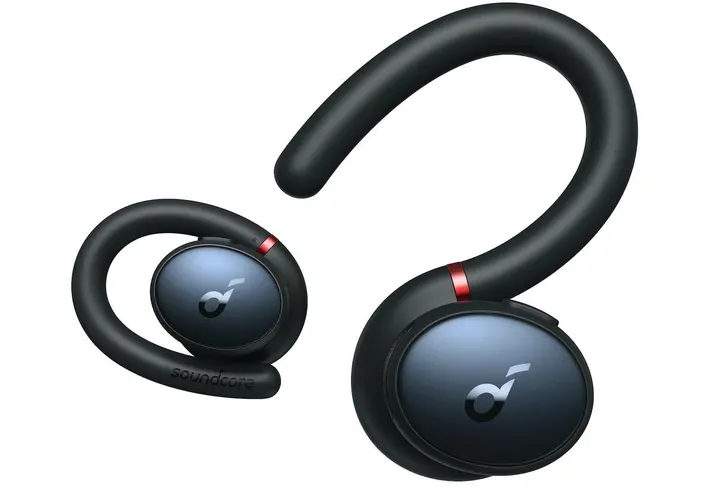
Best Cycle Touring Headphones
Under 70$ [Check The Latest Price]
The Anker Soundcore Sport X10 earbuds come packed with a range of features that cater to workout enthusiasts, but they do have their share of pros and cons.
One standout feature is the rotatable ear hooks, designed to keep the earbuds securely in place during vigorous exercise. However, there’s a notable caveat here – the ear loops tend to be on the short side. This can pose a problem for users with larger ears, as it requires a fair amount of force to get them comfortably positioned.
On the audio front, Sport X10 aims to please with its dynamic acoustic system, promising enhanced bass without sacrificing the clarity of mids and trebles. BassUp technology is a welcome addition, delivering that extra punch of bass in real-time, which can be a motivator during intense workouts.
When it comes to durability, the IPX7 waterproof rating suggests resistance to sweat and rain, making them suitable for outdoor activities such as cycling. However, it’s crucial to heed the manufacturer’s advice against submerging these earbuds completely. Also the effectiveness of the waterproofing may diminish over time.
The battery life is a notable strength, offering 8 hours of playback on a single charge and an additional 32 hours with the charging case. This ensures that you won’t run out of power during extended rides.
The Soundcore X10 also offers a range of useful features like transparency mode, allowing you to stay aware of your surroundings without removing the earbuds, which we’ve already deemed essential for biking safely. Fast charging provides a quick 10-minute charge for 2 hours of listening.
Those Anker Soundcore earbuds are a compelling option for those who crave powerful bass during their bike rides. However, the fit can be problematic, especially for individuals with larger ears, and concerns about long-term durability in sweaty conditions may limit their appeal.
Specs:
- Listening Time: 12h.
- Charging Time: Full Charge – 90 min / 5-minute charge gives 1 hour of playback.
- Controls: Volume/Play/Pause on the cable.
- IPX Rating: IPX7.
Pros:
- Impressive battery life.
- Adjustable cable clip.
- Great sound.
- Friendly customer service.
Cons:
- Can’t connect two devices at the same time.
- Bad mic for calls.
What’s in the box: Sound Core Spirit X, x-Small REMPTY/S/M/L/x-Large ear tips, S/M/L ear wings, 2 x cable clips, shirt clip, Micro USB cable, Travel Pouch, Carabiner, 18-month Warranty.
3. TREBLAB XR500 Cycling Earphones
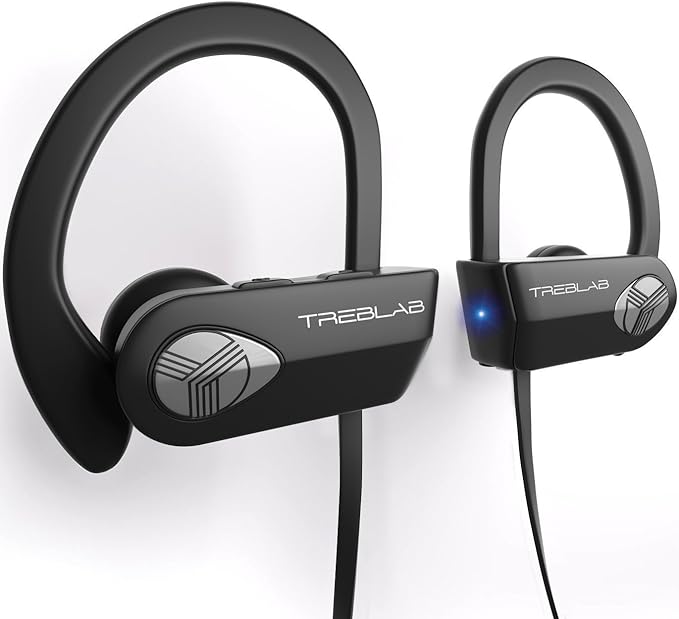
Under 40$ [Check The Latest Price]
Another pair of budget biking earphones with a great sound, this time by TrebLab. Sound and comfort are indeed the biggest pluses, with crisp treble and strong bass, if your device is capable of using the apt-x compression that these earbuds use, the audio quality is outstanding.
The soft silicon ear hooks make them stable but not stiff, although they could slip a bit on very sweaty rides. You can keep them on for hours without feeling discomfort.
TREBLAB XR500 are not active noise-canceling headphones, they use passive noise isolation. You can hear your surroundings but it’s advisable to use only one earphone if you’re riding on unsafe roads.
Using one earbud requires somehow clipping the loose earbud to the jersey or something, not the handiest solution.
The mic for calls is good for the price range, resulting in clear calls, the connectivity though is not the best, Bluetooth 4.1 EDR. The range is 33 feet (10 meters), but they can lose signal if there’s some obstacle between the devices, including your body, so they might have a problem.
IPX4 means they are water-resistant but not waterproof, they come with a 1-year warranty.
Specifications:
- Listening Time: 8h.
- Charging Time: Full Charge – 90 min / 5-minute charge gives 1 hour of playback.
- Controls: on each earbud.
- IPX Rating: IPX4.
Pros:
- Good Battery life.
- Great sound.
- Friendly customer service.
Cons:
- Unstable connection.
- Bad for general awareness.
What’s in the box: TREBLAB XR500 Earbuds – 3 sizes of Silicone Eartips – 3 sizes of Expandable Foam Eartips – Carrying case – Cable Clip – USB/Micro USB Charging cable.
4. JBL Endurance Run
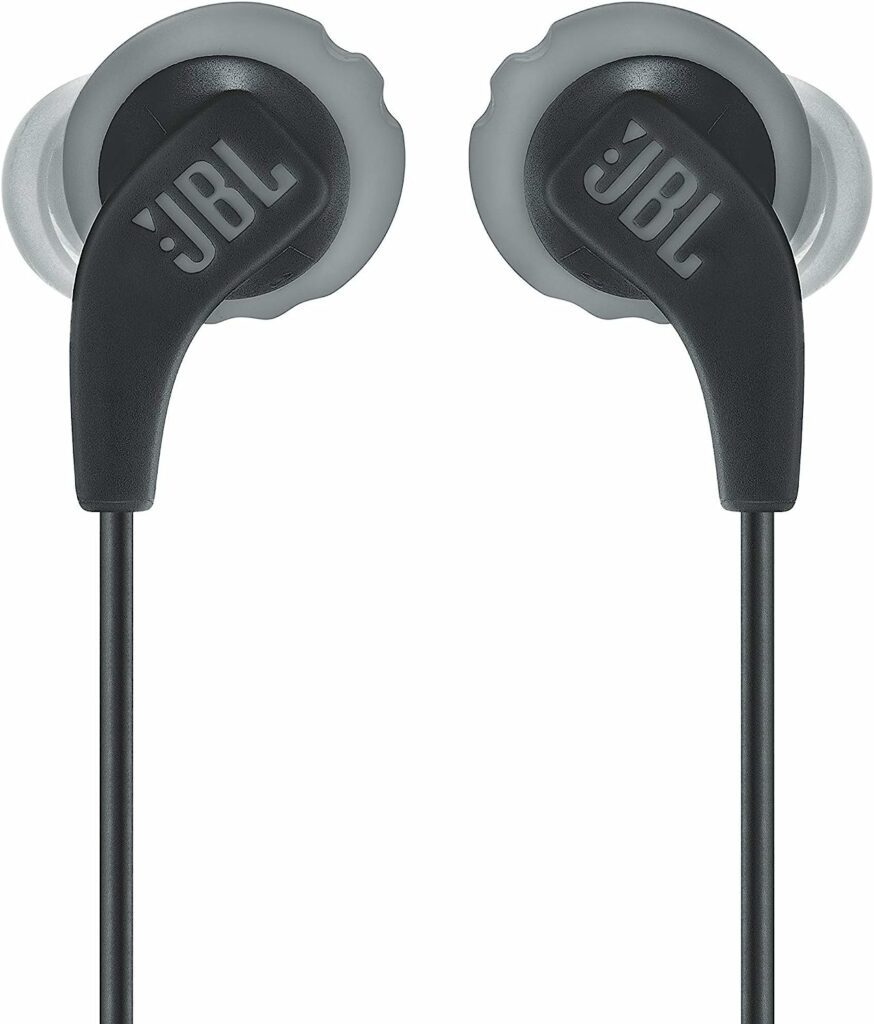
Under 20$ [Check The Latest Price]
Most of the riders don’t want cables in their way, that’s why we are only including one model of non-wireless earphones. In case, there’s someone who doesn’t mind plugging in an old-fashioned way, the JBL Endurance Run is our pick for you.
The flexible flipbook and the two-way design allow you to wear the headphones either in-ear or behind-the-ear, for added comfort and convenience.
A comfortable combination of flex soft ear tips and twist-lock technology means these buds never get annoying or fall out. Thanks to IPX5 sweat/waterproofing, JBL endurance run headphones keep up with any weather, while an in-line microphone and remote ensures you’re never reaching into your pocket to answer calls.
Very good sound for the price, with rich bass and good staging. At this price tag, they are probably the best non-wireless headphones for biking.
Pros:
- Cheap
- Good Sound
Cons:
- Non-wireless
Value for money – 10 | Comfort – 8 | Sound quality – 9 | Noise cancellation – 8
1 Bonus Item – Best Biking Solution?
1. Zulu Audio Magnetic Wearable Speakers
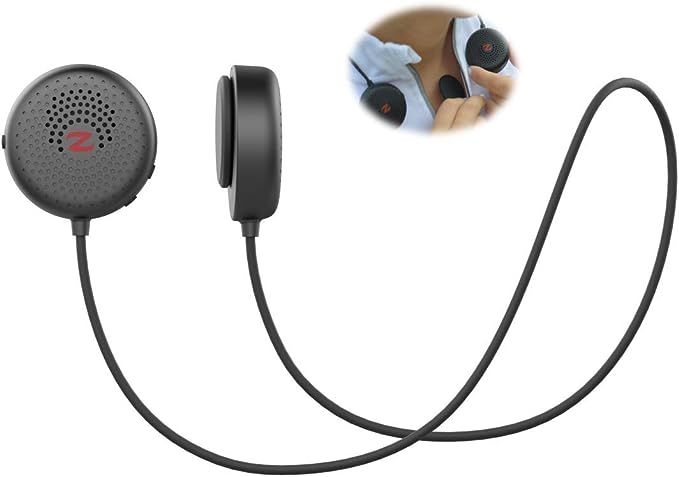
Best Sports Wearable Speakers
Under 40$ [Check The Latest Price]
Have you ever heard of wearable speakers? They are basically small wireless speakers that clip (magnetically or otherwise) to your clothes, such a great solution for listening to music while cycling!
The Zulu Audio is our pick in the category: they pair easily, have easy controls, and a good and loud sound, plus… they don’t cost a kidney.
As with bone-conduction headphones, also wearable speakers have to compromise on immersion to get a high level of awareness of the surroundings. Other people might be able to hear what you’re listening to, but only if they come very close, so that’s not an issue when riding a bike.
The speakers though, are not ultra-small and lightweight (dimensions: 1.83″ x 0.75″ x 1.83″) they can cause a bit of discomfort, but nothing unbearable. The magnets clip together to stay firmly in place while you are running, biking, etc. Wear them on top of your shoulders for the best sound quality.
Like all other products listed in this blog review, the Zulu have a built-in microphone to answer phone calls, they are IPX4 rated (splash and sweat proof, but should avoid full submersion or long/sustained exposure to water).
The main issue for us cycling is battery life, somewhere in between 2 and 4 hours. Might need a power bank to keep them juiced up.
Specs:
- Listening Time: 4h at 75% volume.
- Charging Time: Full Charge in 1h.
- Controls: Easy to use (on the speaker’s side).
- IPX Rating: IPX4.
Pros:
- Great for awareness in traffic.
- Easy pairing.
- Handy controls.
- Reliable Bluetooth connection.
Cons:
- On the Heavy side.
- They bounce a lot (not a big problem for cycling, but annoying for running).
- The cord is a bit uncomfortable.
- Volume is a bit low.
- Short battery life.
What’s in the box: Zulu Alpha Bluetooth Speakers and cord – Magnetic clips – Case – Charging Cable
Cycling with headphones: Awareness VS Immersion
One thing that all of us have to accept is that cycling with earphones on will cripple your overall safety on the road. How much? That depends on various factors:
- Where are you cycling?
- What time of day are you riding?
- How loud is the music/podcast/audiobook are you listening to?
The “where”: If you’re riding a mountain bike trail or on protected cycling paths, being able to hear your surroundings is somehow secondary. But if you’re sharing the road with motorized vehicles you should put your safety first – get headphones with ambient mode or bone conduction… or try out wearable speakers.
The “what time”: early mornings and late nights mean quieter roads, but also less-reliable drivers, if you’re cycling secondary roads at these times of day, you may get a bit more sound immersion, but bear in mind that it’s always a risk.
The “How Loud”: we all like rich bass, and a louder volume gets us going faster, but unless you’re on a protected path, you shouldn’t raise your volume too much. Don’t put yourself in danger by eliminating surrounding sounds
Bone Conduction Headphones – Maximum Awareness

Unlike traditional headphones, which send sound through the ear canals, bone conduction technology delivers audio through the cheekbones. With nothing inside or over your ears, you can enjoy total awareness and comfort while you listen to your music, podcasts, or audiobooks.
Bone-conduction headphones are probably the best solution for cyclists who want to be aware of their surroundings.
Of course, this comes at the price of a compromise, bone conduction headphones can’t sound anything like a good pair of in-ear earphones or buds. But the quality is improving year by year, and some of the bone-conduction headphones listed here have a pretty decent sound!
Pro trick! Bone Conduction can act as noise-canceling headphones by wearing a pair of proper earplugs, an interesting alternative to active noise-canceling earphones/earbuds.
Since this is a relatively “new” technology, bone-conduction headphones make for a great conversation starter, everybody will be curious about them.

What’s best for biking? Bone Conduction VS Earbuds VS Earphones VS Wearable Speakers
The perfect cycling headset simply doesn’t exist, all systems and models have pros and cons, let’s say some generic truths:
Bone Conduction‘s pros are awareness (of course) and comfort; the cons are poor sound quality and battery life.
Earphones (wireless or wired) are usually cheaper, sound good, and har hard to lose, but most will block too much of the outside noise making it dangerous to ride on roads. Another con is the presence of the cable (even on the wireless ones) can be annoying.
Wearable Speakers are another “novelty” and do not always come to mind when thinking of the best sound system for cycling. They are though a very smart option, leaving your ears free to scan surroundings and sound better than bone conduction. The downsides are heavier weight and a bit of bouncing around.
Overall, my personal recommendation is to always put safety before audio quality, as an audio engineer myself with a strong background in music and a never-dying passion, I will still compromise on sound to get a better perception of the surroundings.
That’s why I recommend wearable speakers or bone conduction as the best headphones for cycling. If you want to go for earbuds go for some that have transparency more, unless you only cycle in protected areas with no motorized traffic.
Check Also
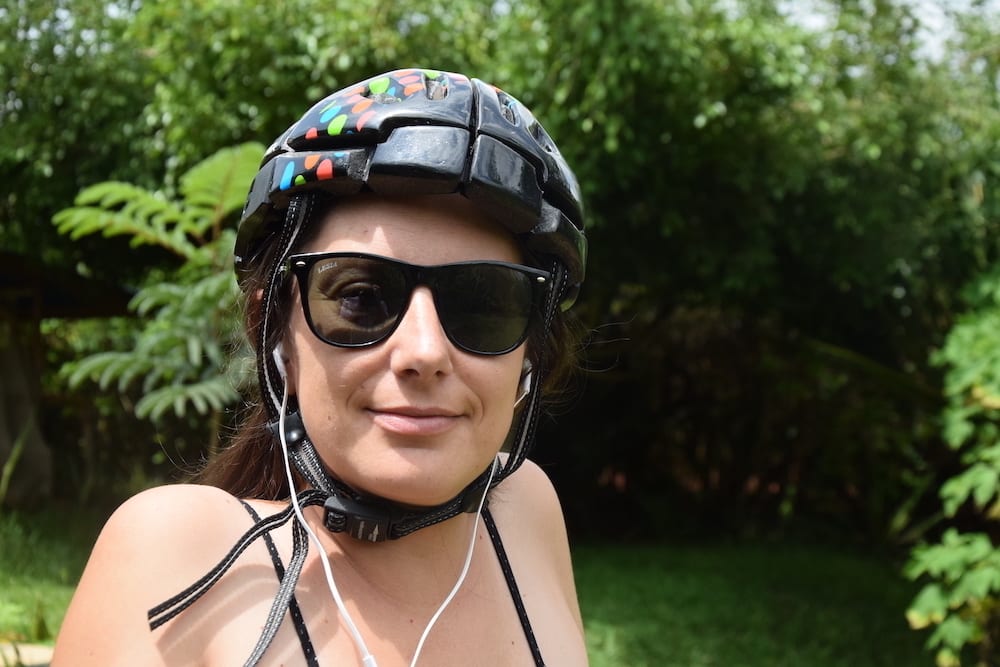
Frequently Asked Questions about Cycling Headphones
Are bone-conduction headphones any good?
Bone conduction technology delivers audio through the cheekbones. Of course, the sensitivity of your bones is not even close to that of your eardrums, so don’t expect the same experience as traditional earphones. Bone conduction headphones though are absolutely great for podcasts and audiobooks.

